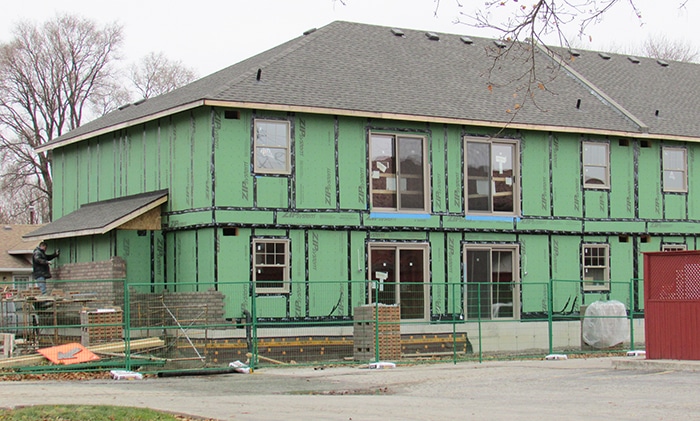
With wait times for affordable housing in Chatham-Kent measured in years, the crisis has put increased pressure on the municipality to come up with a workable strategy sooner rather than later.
In a recent report to council on the rent-geared-to-income centralized wait list (RGI CWL), Housing Director Shelley Wilkins explained that as of Oct. 31, there were 953 households waiting for a vacancy, a number that has increased drastically since 2017.
Wilkins said the wait times for one-bedroom units makes up the majority of applicants; 692 people, with an average wait time range from 4.7 years in Wallaceburg to 3.6 years in Chatham for people aged 16 to 59. For seniors in the 60-64 age range, the wait time for one-bedroom units is the longest at 6.1 years on average.
“The thing that we’ve noticed is the big change that’s happened since 2017 with the drastic drop in the vacancy rates. We noticed the rents trending upward fairly quickly and the vacancy rates drop significantly from 2017 onwards,” Wilkins noted. “I think those two things combined to increase the pressure on the municipality to try and address affordable housing for low-income households.”
Chatham-Kent has a total of 1,592 social housing units, with 1,365 rent-geared-to-income and 126 targeted for market renters. Not surprising, Wilkins said, Chatham has, by far, the greatest number of applicants for all unit sizes, and frustration and stress due to wait times for an offer of housing is a reality.
“In terms of what can be done, the municipality is tackling it to the best of their ability with the resources that we do have, so through the devolution of social housing that happened back in 1998, municipalities were downloaded the responsibility for social housing,” Wilkins noted.
She said the majority of funding for the province is federal funding for social housing, and over time, that funding drops to zero. The Federal Housing Strategy was released in 2017 and is a 10-year plan. The province took a year to come to a bilateral agreement with the federal government on implementation, leaving nine years left.
“In the first three years of the program, there is not as much funding as we used to get, under the Investment in Affordable Housing Program, but we are advised in the second term – the next three years – the funding will significantly increase,” Wilkins said.
Right now, Wilkins noted, C-K is in the first three years of it, so the funding does not look great for the municipality. While this is happening, she explained, the municipality is on the downward slope of losing federal funding so council has been proactive since 2018, establishing a base budget for affordable housing at $500,000, and then increased it to $800,000 last year.
“We’re hoping to see them add to that again in 2020. I also have a request into them for significantly increasing the funding for Portable Housing Benefits (PHB),” the director said.
PHB follows the person, instead of being attached to a housing unit, to allow more access to applicants to an affordable rental unit. Wilkins said it is different from RGI subsidy, which is place-based and is calculated based solely on income, going up and down depending on income level. The PHB differs, she said, because it is an allowance program with flat rates.
“You’re either at the individual/couple rate or you’re at the family rate. If your income goes up to make you ineligible, that’s one thing, but you get a little more as you need a little bit more or a little bit less as you need a little bit less,” she added. “It’s a little less administrative work and it does stay with the person or family, so they are free to move wherever they want and the money goes directly to them.”
The PHB program numbers are not included in the CWL report, she noted. It also gives the recipient privacy as the landlord doesn’t know he or she is receiving assistance with rent costs.
Wilkins said her request to council is to add another 63 units of portable housing. She said when they looked at the numbers, they had a number of people “age in place,” transitioning to CPP or other pension earnings and therefore ineligible for RGI assistance, but “they have opted to continue living where they’re at and I think that is understandable given that the vacancy rate is so low and rents in their price range aren’t available.”
“The other thing is that rent has gone up significantly in the last five years, so if anyone has been in social housing, it is very compact and modest in terms of amenities and size. They are relatively small units, so if you have made an increase in your income, most people would opt to find other housing if they could afford something a little larger, but the difficulty is finding something still in their price range,” Wilkins explained. “Under the Residential Tenancies Act, there is nothing in there that allows us to ask or require people to move out of social housing when they no longer need RGI assistance so they are free to stay as market renters, but we need to replace those units, so that’s why I’m asking council to increase our portable housing units.”
The director said it’s a good start with PHB, but “with close to 1,000 people on our waiting list, (63 units) is just a drop in the bucket, I recognize that for the people that have to wait in excess of years. It’s very tough for people to make ends meet until they’re provided that additional help with their rent, whether it’s being housed in social housing or receiving assistance with their rent.”
Wilkins said that is why you see the increased use of food banks, church-based groups and service clubs who offer assistance.
There have been affordable units lost in the municipality to condo conversions and she said multi-residential construction hasn’t kept pace with the need, especially at the low end of the market.
“The only affordable housing that’s been built since social housing stopped being built in the ’90s is the housing that the municipality has entered into contribution agreements with and provided federal/provincial funding to, and in more recent years, municipal funding,” Wilkins noted. “We have a report that will go to council in the New Year that will include a number of recommendations on how we could try to encourage the development of more affordable housing. I’m hoping that is going to make a big difference.”
Through the National Housing Strategy, there is a program called Co-Investment Funding that does provide options to potential developers as well, administered by Canada Mortgage and Housing Corporation (CMHC). She said it is not as simple and straightforward as the funding the municipality can provide through federal/provincial funding. They have a bit more flexibility in what they do, Wilkins noted, but makes it a bit more “gray” for the applicants.
“CMHC does provide seed funding which is really significant help for potential developers to do the pre-development work so that they don’t have to bear all those costs alone, and if the project doesn’t proceed, they don’t have to pay it back,” she said.
Getting the proper zoning for the projects is a big part of the process as well for multi-residential units. Some people are opposed to affordable housing in their neighbourhood and while they acknowledge it is needed, they don’t want it in their backyard.
“We have some beautiful affordable housing projects that there is just no reason for that fear. It is totally unsubstantiated and doesn’t prove out when the project is done,” Wilkins said. “Most people would not know it is an affordable housing project if we hadn’t stated it.”
There are a couple projects in Chatham that are in the works to add units, such as the one on St. Clair Street and another on Michener Road.
“Under the provincial/federal funding program, they have two years to complete their project, and depending on how difficult they are. In most cases, we are seeing an average of 14 to 15 months to complete a build,” the housing director said. “You announce and people feel like it is taking forever before they can make it available.”
Social housing is different than affordable housing, something Wilkins said she is trying to get council to understand.
“For social housing, for RGI, we are providing ongoing subsidy to those units. For affordable housing, what the proponent gets in response to building of the affordable unit project, for the affordable unit funding, they are committed to a 25-year legal agreement with us whereby they have to provide rent at 20 per cent below the average market rent. The only thing they have to do is ensure that the people going into those units are filtered by us and we make sure they meet the income thresholds for the affordable units,” Wilkins said. “They are only funded for the affordable units.”
The agreements have been increased to 25 years with a five-year phase out at the end.
Cuts to capital funding projects for other groups in need in the area have also posed additional problems with wait times.
“When you only build a few units a year and there is so much need in the community, including Community Living, March of Dimes, Chatham-Kent Women’s Centre who are not on our wait list, the municipality is close to the only option for getting capital funding for affordable housing and that adds to the pressure,” Wilkins noted.
A Service Level Standards Action Plan is coming to council Wilkins said at council’s direction, to further address the affordable housing crisis and what further incentives can be taken.






